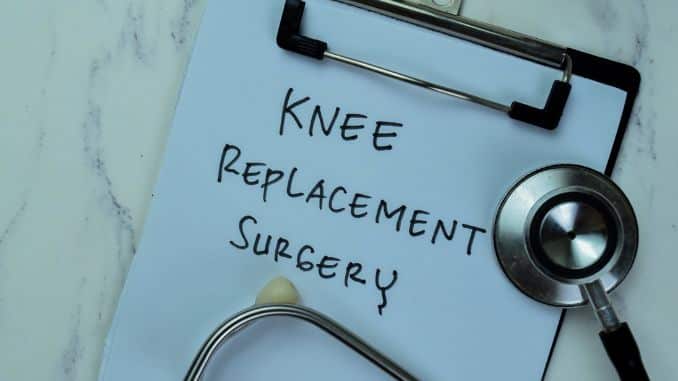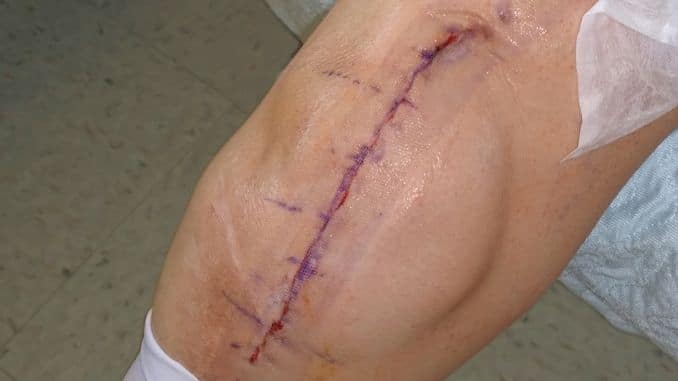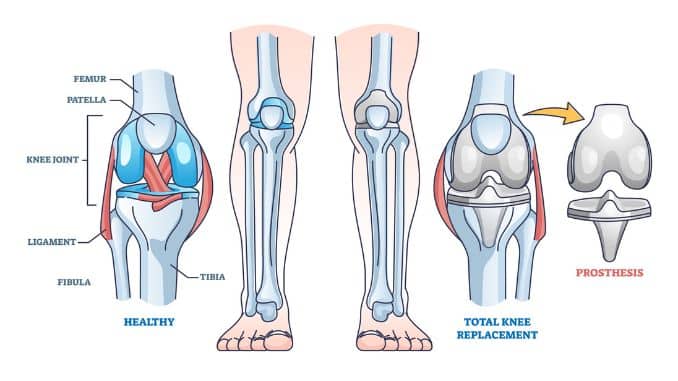
For older adults, medical conditions that cause the cartilage to wear out and lose the cushion for the knee joint, such as osteoarthritis, are very common. With this, regular activities like taking the stairs, sitting on a couch, or even gardening could cause unbearable pain, and life will not be the same as before. A knee replacement surgery is often the most sought out operation for this. Knee replacement surgery or knee arthroplasty is now a common operation among older adults. According to the American Academy of Orthopedic Surgeons, more than 790,000 knee replacement surgeries are performed in the United States every year. The main goal of this surgery is to relieve pain. It also improves the range of motion and gets back to regular daily activities with the Knee Replacement Surgery Exercises.
However, unbeknownst to many, it doesn’t end after undergoing knee replacement surgery. You will need to go through rehabilitation. This involves different exercises to regain and achieve the highest function of your knees. Without this, complications may arise that could again hinder your life.
What Is Knee Replacement Surgery?
A Knee Replacement Surgery or Knee Arthroplasty is a surgical procedure that involves replacing a severely damaged or worn-out knee with an artificial joint (or prosthesis) made of metal alloys, high-grade plastics, and polymers. The primary goal of this treatment is to relieve pain, improve mobility and restore function.
To get this type of surgery, your doctor will assess your knee, its range of motion, strength, stability, and the extent of damage. With this, they may recommend the most suitable procedure for you.
Anatomy Of The Knee Joint
The knee joint is a hinge-type synovial joint. It allows the flexion and extension of the knee and a small degree of lateral and medial rotation. Several articulations between the patella, femur, and tibia form this joint.
This joint has two articulations, the tibiofemoral and patellofemoral. Hyaline cartilage lines these articulations. The first articulation is the tibiofemoral. The articulation of the medial and lateral condyles of the femur with the tibial condyles forms this. second articulation is the patellofemoral. Articulating the anterior aspect of the distal femur with the patella forms this. The patella, which is located within the quadriceps femoris tendon, actually stands as a fulcrum to increase the power of the knee extensor. It also stabilizes and decreases friction placed on the femoral condyles.
A fibrocartilage structure is present in the knee, the medial and lateral menisci, both attached at the end of the intercondylar area of the tibia. It has two main functions. One is to provide depth in the articular surface of the tibia to increase the joint’s stability. And second, is increasing the surface area to equalize.
A synovial-filled fluid sac called a bursa is inside the joint. Its function is to reduce friction between the articular surfaces to avoid wear and tear. The joint has four bursa, namely the Suprapatellar bursa, Prepatellar bursa, Infrapatellar bursa, and Semimembranosus bursa.
There are three major ligaments in the knee joint. The patellar ligament is located at the distal part of the quadriceps femoris tendon that serves as its continuation and attaches to the tibial tuberosity. The two collateral ligaments, the Tibial (medial) collateral ligament and the Fibular (lateral) collateral ligament, act as stabilizers to the hinge motion of the knee, preventing excessive medial or lateral movement. The two cruciate ligaments are the anterior and posterior cruciate ligaments. connect the femur and the tibia. Flexion, extension, medial and lateral rotation limit the movement of the knee joint.
What Happens In Knee Replacement Surgery?
In a knee replacement surgery, one or both of your knee joints are replaced, usually lasting 1-3 hours. During the surgery, your surgeon will cut down the skin in front of your knee to expose your kneecap. Move the kneecap to the side to see the knee joint located behind it. We will precisely measure and cut the ends of your thigh bone and shin bone, which are damaged, to fit the prosthetic replacement. A curved metal will replace the end of your thigh bone, while a flat metal plate will replace the end of your shin bone. Surgeons attach these using special bone cement and insert a plastic spacer between them to act like cartilage, thus reducing friction as it moves.
They place a dummy joint on it to test whether the joint could work properly, and make adjustments if needed. The surgeon fits the prosthesis to the joint after this. The doctor will either stitch or clip the opening to close the wound, and then apply a dressing.
Why Do We Need To Undergo Rehabilitation Following A Knee Replacement Surgery?
After the surgery, you are likely to have some difficulty moving it, especially bending the knee. If little to no movement happens to your knees, the muscles around it may weaken and could cause limitation of movement. Rehabilitation that involves exercises and knee joint pain management after a Knee Replacement Surgery is essential as it aims to increase the strength and range of motion of the knee. With continuous rehabilitation, one could achieve the highest function of the knees and could therefore go back to activities of daily living with lesser complications.
What Happens When You Don’t Do Rehabilitation After Knee Replacement Surgery?
Skipping your Knee Replacement Surgery Exercises or not doing them at all is not a good idea. A negative consequence can happen to you while recovering.
Here are some of the following:
-
Muscle Atrophy
Muscle Atrophy is the wasting of muscle mass. When a muscle is not often used or activated, the muscle mass is decreased, resulting in other symptoms like weakness, numbness, and tingling sensation. The operated leg will look thinner than the unoperated leg.
-
Limitation Of Motion
If you are inconsistent with your exercises, stay idle for too long, and are not fully committed to rehabilitation, your knee may become stiff. If this happens, you may have difficulty bending or straightening your knees, which may cause chronic issues like pain as well. The risk of having a pre-surgery becomes higher too.
-
Slower Healing
To get the blood flowing, movement is needed. When exercising, the surgery site could have better blood flow which could promote healing, prevent scar tissue formation, and prevent blood clots. Thus, when one doesn’t do it often, it may slow down the healing process and cause another complication.
Introducing The Knee Replacement Handbook: Its Benefits And Why Do You Need It?
The Knee Replacement Handbook is an exercise program specifically made for men or women between the ages of 50 and 90 who have had (or will have) knee replacement surgery, knowing fully well that people in this situation have unique and specific exercise needs and capabilities.
The movements and exercises in this routine are extremely gentle, safe, and easy on your joints. This program follows a gradual progression model that starts you out with a very low-impact, low-intensity, and short-duration routine – one that virtually any person can do, regardless of age, fitness, or exercise experience.
The Knee Replacement Handbook involves a holistic approach that involves 10 different methods:
1. Icing
Ice packs are very effective for reducing swelling and inflammation in your knee joint and the surrounding tissue.
2. Squatting
Squatting helps strengthen your knees. being the largest joint in your body, the knees need to be strong enough to carry your body weight. Moreover, researchers have proven the statement that squatting is bad for the knees to be false. Squatting has many advantages if done properly.
However, when it comes to squatting or even kneeling after knee replacement surgery, this may not be possible with these implant models. You will need to get a high-flexion knee joint implanted. In this program, you will be taught the proper way of squatting. Also, alternative squatting movements will be suitable for someone who had a knee replacement
3. Forward Transfer
After having a knee replacement, you may expect your lifestyle to be a lot like it was before surgery— but without the pain. In many ways, you are right, but returning to your everyday activities takes time. Being an active participant in the healing process can help you get there sooner and ensure a more successful outcome.
Even though you will be able to resume most activities, you may have to avoid doing things that place excessive stress on your “new” knee, such as participating in high-impact sports like jogging. This Knee Replacement Surgery Exercises program will help you enjoy your new knee while you safely resume your daily activities. especially when it comes to movements that will require you to bend forward, like sitting to standing.
4. Hamstrings Strengthening
Your hamstring muscles work to bend your knee and extend your hip backward. Keeping your hamstrings strong after injury or surgery can help you return to normal walking ability.
5. Gluteus Maximus Strengthening
Gluteus maximus is one muscle that is responsible for the movement of the hip and thigh. Standing up from a sitting position, climbing stairs, and staying erect are all aided by the gluteus maximus. Therefore, it is important that this muscle has enough strength to help the “new” knees move and stabilize the leg, especially from sitting to standing position.
6. Quadriceps Strengthening
The quads are essential to knee stability and movement. They keep the knee from buckling and enable standing and walking.
7. Knee Flexion Exercises
After knee replacement, knee flexion is a challenge. In this program, you will be taught the correct method of performing knee flexion exercises.
8. Knee Extension Exercises
The most common complication and cause for poorer outcomes following knee replacement is motion loss, particularly loss of full knee extension. The inability to fully extend the knee results in abnormal joint motions, scar tissue formation in the front of the knee joint, and subtle changes in normal knee mobility.
Thus, one of the goals of this program is to achieve at least full extension and even some degree of hyperextension during the first few days postoperatively. As you progress and the knee’s homeostasis is restored, this program will eventually work to restore your symmetrical knee extension motion.
9. Ankle Mobility
Strong and flexible feet, ankles, and calves provide our base for stable movement and are essential for performing our daily activities without pain or strain. Research has shown that a lack of ankle mobility can increase rotational torque at the knee. This aligns with the joint-by-joint school of thought with respect to training; if you lock up a joint that should be mobile, the body will look elsewhere to create that range of motion. Having that said, this program will help improve your ankle mobility. This is essential in hastening your stability and weight-bearing tolerance and capabilities.
10. Cardiovascular Training
Almost everyone is aware of the health benefits of regular cardio Knee Replacement Surgery Exercises. They make your heart and lungs more efficient, giving you increased stamina and energy levels throughout the day. However, if you have problems with the weight-bearing joints of your body, particularly the hips, and knees, cardio exercises of the high-impact variety may not be an option for you. This program offers excellent alternatives to get your heart pumping and boost your metabolism without compromising your ‘new” knees.
Do’s And Don’ts After Knee Replacement Surgery
Here are some do’s and don’ts to help you during your recovery:
-
Do Take Your Rehabilitation Seriously
It’s important to follow your doctor’s instructions and advice carefully and diligently. You should perform all the exercises prescribed by your Physical Therapist, even when it’s painful and uncomfortable. Keep in mind that a positive and successful outcome of the surgery depends not only on the surgeon’s success but also on the patient’s willingness to work hard during rehabilitation. So try your best to be consistent about it, and it will surely bring a result that is worth it. Taking medications as well as getting adequate rest is important too.
-
Do Use Cold/Heat Therapy
After the surgery, swelling is often expected that can last for three to six months. To help reduce the swelling, including pain and inflammation, cold therapy using ice packs is usually recommended for the first few days after the surgery. Gently put it in the painful area three or four times a day, 10-20 minutes. If the swelling is gone, alternately using cold and heat therapy can help relax the muscles, reduce stiffness, and increase the blood flow, which could foster a better healing environment on the structures involved.
-
Do Your Best To Be Healthy
Being and keeping your body healthy contributes to your recovery after surgery. Keep your weight down. Extra weight also puts extra pressure on your joint, which can slow your healing.
Smoking, as well as drinking alcohol, should be avoided too. Smoking shrinks your blood vessels which could cause slower healing. Lastly, Knee Replacement Surgery Exercises or doing low-impact activities such as walking, swimming, or pedaling a stationary bike can be beneficial as it strengthens the muscles in your legs and improves overall blood flow.
-
DON’T Put Unnecessary Pressure On Your Joints
Try to avoid lifting heavy things during your recovery. Doing proper body mechanics is also important to avoid further injury to the joint. For example, when turning, make sure to turn your entire body to avoid twisting the knee. Certain steps could be done when you are going to be sitting, kneeling, bending down, and more. Your Physical Therapist can guide you on the proper way of doing these things with your operated knee joint.
-
DON’T Give Up
Recovery is not the same for everyone. Some may recover faster than others, but it doesn’t mean you won’t recover at all. All individuals and surgeries are different. Several factors like age, type of surgery, and more affect this. It’s important to have patience and consistency, as these are the keys to unlocking your overall recovery.
Takeaway
Following a Knee Replacement Surgery, you will likely encounter several challenges and pain on your journey toward recovery. While it is difficult, you must remember that what you’ll do after the surgery is just as important to the overall success of the surgery as the surgery alone. Remember to consult your doctor if you experience any severe pain or swelling, open wound, and other insignificant changes to have a speedy Knee Replacement Surgery recovery.
Get back to your life the way it was before surgery and all this terrible knee pain with our Knee Replacement Handbook. What are you waiting for? Order yours now.





